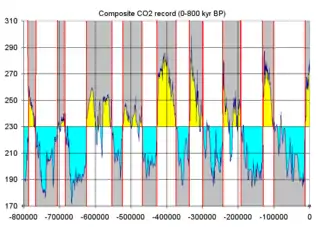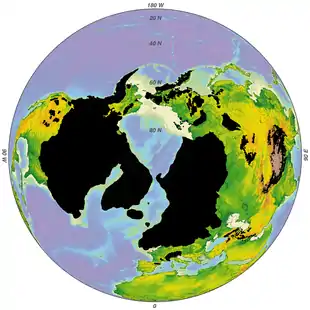Glacial period
A glacial period (alternatively glacial or glaciation) is an interval of time (thousands of years) within an ice age that is marked by colder temperatures and glacier advances. Interglacials, on the other hand, are periods of warmer climate between glacial periods. The Last Glacial Period ended about 15,000 years ago.[1] The Holocene is the current interglacial. A time with no glaciers on Earth is considered a greenhouse climate state.[2][3][4]
| Look up glaciation in Wiktionary, the free dictionary. |
Quaternary Period

Within the Quaternary (about 2.6 Ma to present), there have been a number of glacials and interglacials.[5] At least eight glacial cycles have occurred in the last 740,000 years alone.[6]
Penultimate Glacial Period
The Penultimate Glacial Period (PGP) is the glacial period that occurred before the Last Glacial Period. It began ~194,000 years ago, and ended 135,000 years ago with the beginning of the Eemian interglacial.[7]
Last Glacial Period
The last glacial period was the most recent glacial period within the Quaternary glaciation, occurring in the Pleistocene, which began about 110,000 years ago and ended about 15,000 years ago.[1] The glaciations that occurred during this glacial period covered many areas of the Northern Hemisphere and have different names, depending on their geographic distributions: Wisconsin (in North America), Devensian (in Great Britain), Midlandian (in Ireland), Würm (in the Alps), Weichsel (in northern central Europe), Dali (in East China), Beiye (in North China), Taibai (in Shaanxi) Luoji Shan (in southwest Sichuan), Zagunao (in northwest Sichuan), Tianchi (in the Tian Shan) Jomolungma (in the Himalayas), and Llanquihue (in Chile). The glacial advance reached the Last Glacial Maximum about 26,500 BP. In Europe, the ice sheet reached Northern Germany. In the last 650,000 years, there were, on average, seven cycles of glacial advance and retreat.
Next glacial period
Since orbital variations are predictable,[8] computer models that relate orbital variations to climate can predict future climate possibilities. Work by Berger and Loutre suggests that the current warm climate may last another 50,000 years.[9] The amount of heat trapping (greenhouse) gases being emitted into Earth's oceans and atmosphere may delay the next glacial period by an additional 50,000 years.[10][11]
See also
- Climate
- Cyclostratigraphy
- Geologic time scale
- Glacial history of Minnesota
- Glacier
- Greenhouse and Icehouse Earth
- Ice age
- Interglacial and Interstadial periods
- Last Glacial Maximum
- Last Glacial Period
- Penultimate Glacial Period
- Milankovitch cycles
- Precession (astronomy)
- Quaternary glaciation
- Snowball Earth
- Timeline of glaciation
- Yarkovsky effect
- YORP effect
References
- J. Severinghaus; E. Brook (1999). "Abrupt Climate Change at the End of the Last Glacial Period Inferred from Trapped Air in Polar Ice". Science. 286 (5441): 930–4. doi:10.1126/science.286.5441.930. PMID 10542141.
- Bralower, T.J.; Premoli Silva, I.; Malone, M.J. (2006). Bralower, T.J; Premoli Silva, I; Malone, M.J (eds.). "Leg 198 Synthesis : A Remarkable 120-m.y. Record of Climate and Oceanography from Shatsky Rise, Northwest Pacific Ocean". Proceedings of the Ocean Drilling Program. Initial Reports. Proceedings of the Ocean Drilling Program. Proceedings of the Ocean drilling program. 198: 47. doi:10.2973/odp.proc.ir.198.2002. ISSN 1096-2158. Retrieved April 9, 2014.
- Christopher M. Fedo; Grant M. Young; H. Wayne Nesbitt (1997). "Paleoclimatic control on the composition of the Paleoproterozoic Serpent Formation, Huronian Supergroup, Canada: a greenhouse to icehouse transition". Precambrian Research. Elsevier. 86 (3–4): 201. Bibcode:1997PreR...86..201F. doi:10.1016/S0301-9268(97)00049-1.
- Miriam E. Katz; Kenneth G. Miller; James D. Wright; Bridget S. Wade; James V. Browning; Benjamin S. Cramer; Yair Rosenthal (2008). "Stepwise transition from the Eocene greenhouse to the Oligocene icehouse". Nature Geoscience. Nature. 1 (5): 329. Bibcode:2008NatGe...1..329K. doi:10.1038/ngeo179.
- Gibbard, P.; van Kolfschoten, T. (2004). "Chapter 22: The Pleistocene and Holocene Epochs" (PDF). In Gradstein, F. M.; Ogg, James G.; Smith, A. Gilbert (eds.). A Geologic Time Scale 2004. Cambridge: Cambridge University Press. ISBN 978-0-521-78142-8.
- Augustin, Laurent; et al. (2004). "Eight glacial cycles from an Antarctic ice core". Nature. 429 (6992): 623–8. Bibcode:2004Natur.429..623A. doi:10.1038/nature02599. PMID 15190344.
- Climate dynamics during the penultimate glacial period recorded in a speleothem from Kanaan Cave, Lebanon (central Levant) http://minerva.union.edu/gillikid/pdfs/Nehme_etal_2018_QR.pdf
- F. Varadi; B. Runnegar; M. Ghil (2003). "Successive Refinements in Long-Term Integrations of Planetary Orbits" (PDF). The Astrophysical Journal. 592 (1): 620–630. Bibcode:2003ApJ...592..620V. doi:10.1086/375560. Archived from the original (PDF) on 2007-11-28.
- Berger A, Loutre MF (2002). "Climate: An exceptionally long interglacial ahead?". Science. 297 (5585): 1287–8. doi:10.1126/science.1076120. PMID 12193773. S2CID 128923481.
- "Global Warming Good News: No More Ice Ages". LiveScience. 2007.
- "Human-made climate change suppresses the next ice age". Potsdam Institute for Climate Impact Research in Germany. 2016.
